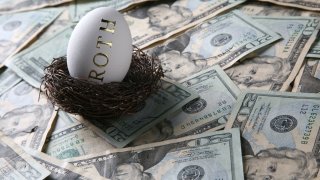
- Peter Thiel, one of Paypal's founders, had $5 billion in a Roth IRA as of 2019, after a value of under $2,000 in 1999, according to a new ProPublica report.
- He apparently used a self-directed Roth account, which lets you hold alternative assets — i.e., private company shares or real estate — that you generally can't invest in through a regular Roth.
- The strategy is available to all investors, not just the wealthy.
Sometimes, it can seem like only rich people can benefit from the tax code.
Some ultra-wealthy individuals have amassed hundreds of millions — or even billions — of dollars in tax-sheltered Roth individual retirement accounts, according to a report released Thursday from ProPublica, an investigative news outlet. However, the strategy is generally available to anyone who wants to use it.
Feeling out of the loop? We'll catch you up on the Chicago news you need to know. Sign up for the weekly Chicago Catch-Up newsletter here.
"The great thing about the Roth is that it's everyone's best tax shelter," said Ed Slott, CPA and founder of Ed Slott and Company.
More from Personal Finance:
How to craft an inflation strategy using muni bonds
Certificate of deposit rates hit all-time lows
Most workers wait years for 401(k) matches to vest
For traditional 401(k) plans and IRAs, you generally get a tax break when you make contributions and then pay taxes on the withdrawals in retirement. In contrast, Roth versions of those accounts come with no upfront tax break, but qualified withdrawals are excluded from federal income taxes.
Money Report
While there are income limits set for who can contribute directly to a Roth, investors with higher income are able to convert assets in a traditional IRA or 401(k) — whose withdrawals in retirement are taxed as ordinary income — to a Roth.
Taxes are paid on the money converted, yet it then can grow tax-free and be withdrawn completely tax-free as long as you have held the account for at least five years and are age 59½ or older.
Among the billionaires who have exploited the rules for Roth IRAs is Peter Thiel, one of Paypal's founders, whose account was worth $5 billion as of 2019 after a value of under $2,000 in 1999, according to the ProPublica report. (CNBC has not independently verified any details in the report.)
A self-directed Roth IRA
Thiel apparently used a self-directed Roth IRA to shelter his investments. This type of account comes with the same tax benefits as a standard Roth account — tax-free growth and untaxed distributions — but also allows you to invest in assets that are unavailable in regular Roth accounts.
For instance, a self-directed Roth IRA can hold investments such as real estate or private company shares, the latter of which is what Thiel first held in his account in 1999 before PayPal was a publicly traded company, according to ProPublica.
Self-directed IRAs typically are only available through specialized custodians, not big financial firms such as Fidelity Investments or Vanguard, which offer a broad range of investments such as publicly traded stocks, bonds, mutual funds and the like.
In contrast, custodians that hold self-directed IRAs have nothing to do with the investments you put in your account.
"They won't police you," Slott said. "They won't advise you about breaking tax laws — that's on you. You have to know what you're doing."
In addition, there are valuation issues, he said. While you can know the worth of publicly traded securities, some alternative assets are harder to value, and the onus is on you to get it right so you don't run afoul of tax laws.
However, once the assets are in the account, you can sell them at some point — presumably at a profit — and use the proceeds to purchase other investments in the account, all under the tax-free Roth umbrella.
Even if a self-directed Roth IRA wouldn't be a good fit for you, you'd still get the tax benefits if you invest through a standard Roth IRA.
"Anything you think has high growth potential should go in a Roth," Slott said.
Roth accounts also can help avoid the uncertainty of where tax rates will be when you retire, Slott said.
If your money is in a traditional IRA or 401(k), meaning it will be taxed upon withdrawal, the rate you end up paying may be higher than where tax rates are today. Additionally, Roth accounts have no required minimum distributions — amounts that must be distributed annually once you reach age 72 — during the original account owner's lifetime.






